WEBlog - discover interesting things about your employees.
All posts
10+ Time Management Systems to Level Up Productivity
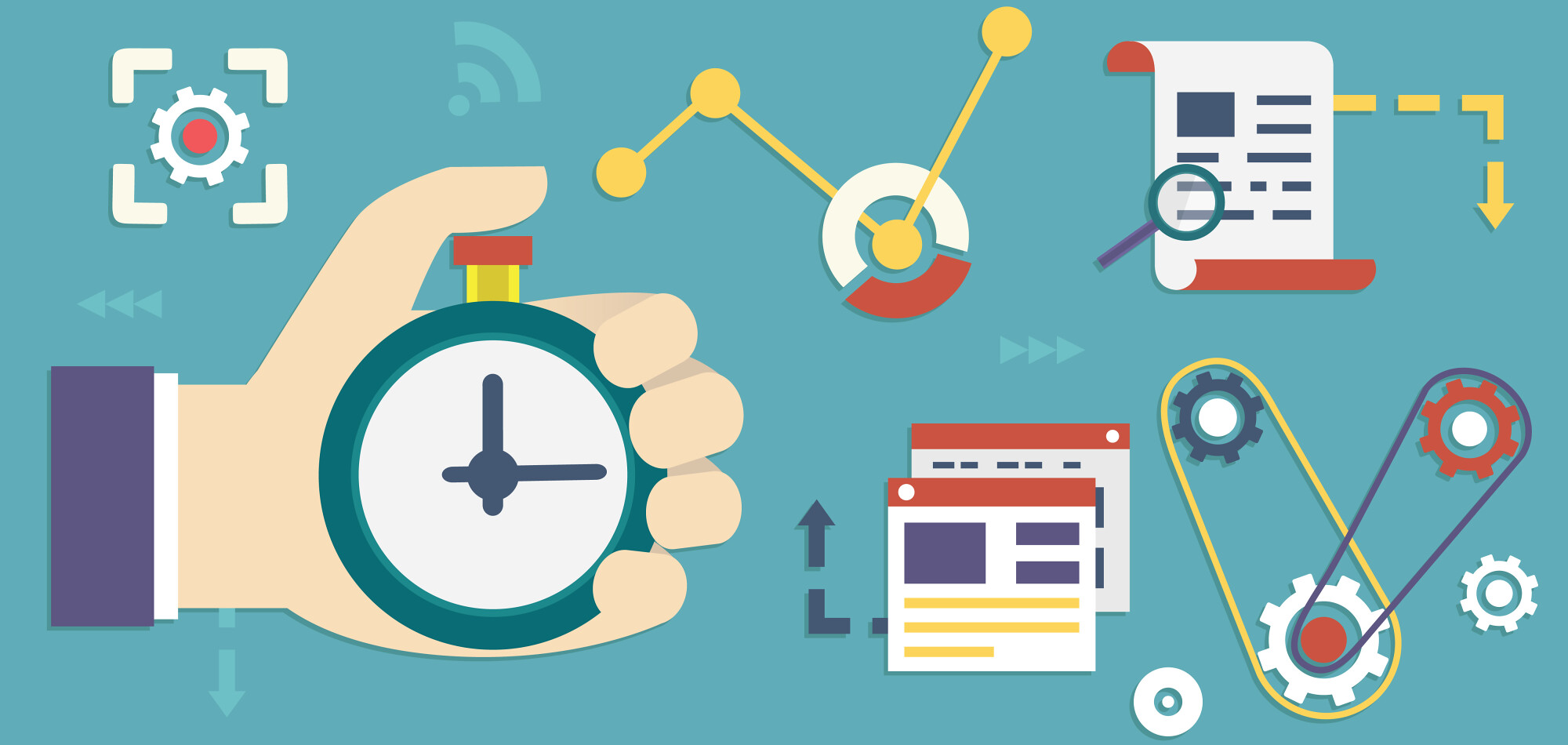
If you feel like being over your head in tasks, with deadlines always missed and the pressure only growing, we are dead sure you have to master a time management system and get your time more efficiently organized. Whether you are an employer, an employee, or a freelancer, you will be able to pick a suitable system from our selection of viable methods. They are paired with the best digital solutions to help you in your journey to higher productivity.
1. GTD
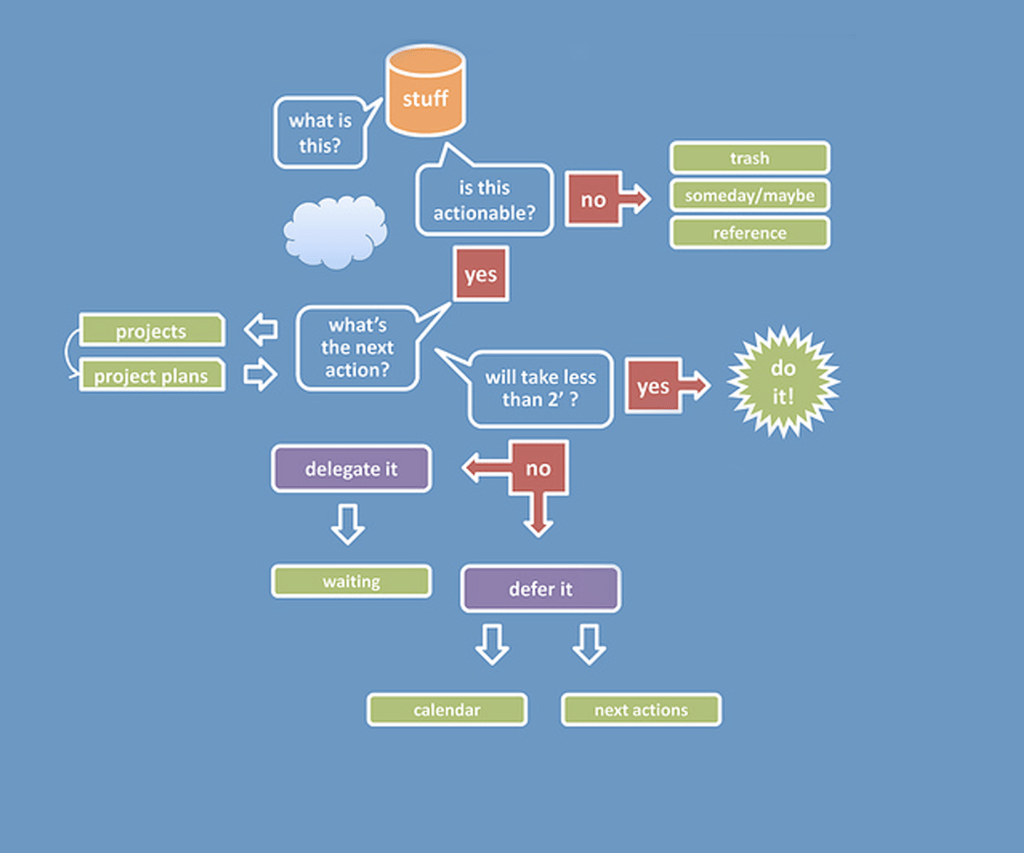
It’s, probably, the most celebrated time management system across the globe, but if you happen to belong to millennials or zoomers, you might have missed the opportunity to read Getting Things Done by David Allen. The author is known as an expert in time management and personal productivity, while the book was first published in 2001 and reissued in 2015 with changes made to better adjust the method to the digital era. The system received positive reviews from Time Magazine, The Guardian, and CNN, among other respectful sources, and even got support through scientific research on psychology and cognition.
The Essence
GTD is based on the principle that a person must free their mind from memorizing current tasks by transferring them and associated reminders to an external medium. It helps unload the mind, relieves stress, and shifts the focus on performing the tasks instead of being distracted by unsettled matters stuck in the head. With that, the tasks must be clearly defined and split into specific actions with established time limits to provide a kind of step-by-step guide on the way to the goal.
While time management systems are usually built on prioritization, GTD offers two other elements — control and perspective. They are implemented via three basic models:
- workflow management
- six-level work review model
- natural planning method
The first model to master is workflow management, which helps take control of all tasks and assignments. It consists of five steps:
- Capture. Here you need to unload your mind by transferring all more or less important tasks to an external medium, which can be anything from a voice recorder to a sheet of paper.
- Clarify. At this stage, you should process the list starting from the very top item and never returning it on the list again. If the item requires action, you need to do it immediately (provided it takes less than two to five minutes), or delegate it, or put it off. If the item requires no action, leave it for reference, or throw it away, or label it as Someday/Maybe.
- Organize. All the items that are not deleted or done should be categorized and broken down into a list of actions with priority ranks, deadlines, and reminders attached. To this end, you can use a calendar and Next actions, Projects, Waiting for, and Someday/Maybe lists.
- Reflect. GTD requires reviewing all the activities, projects, and pending items at least weekly to ensure that new tasks or upcoming events are entered into the system and everything is up to date.
- Engage. Decide which actions to do based on priority, context (what can you do here and now), and time/energy available.
While workflow management addresses the control issue, GTP’s six-level work review model deals with perspective. It implies reviewing your goals weekly by going down the following levels:
- current actions
- current projects
- areas of responsibility
- goals for 1-2 years
- 3-5 years perspective
- life
The third of GTD’s main models copes with cases that require deeper consideration. It helps in planning projects and consists of five stages:
- defining a purpose and principles
- envisioning the desired results
- brainstorming
- arranging a doable list
- determining the next specific action
Who Will Benefit
Although the system is even more complexly structured, you will be able to increase productivity and decrease daily pressure by learning the basics. GTD is flexible enough to inspire creative minds and customizable for both freelancers and business owners. It works equally fine for streamlining household chores, organizing private affairs, and tackling work-related tasks.
Digital Tools to Take On Board
GTD comes with an abundance of recording to keep all the things organized, which, of course, can be done with physical lists, day planners, and folders. However, you can do better with a hi-tech approach and user-friendly apps.
- digital calendars by Google, Microsoft, or Apple
- list managers like Todoist, Microsoft OneNote, or Trello
- capture tools, such as Evernote or Braintoss
- solutions for brainstorming, for example, TheBrain or MindManager
2. Pomodoro
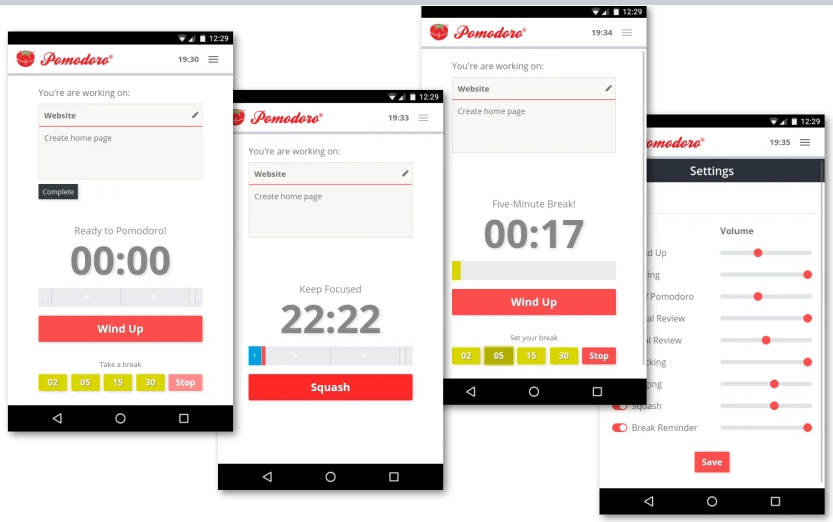
The Pomodoro technique is even more ancient than the previous method since it popped up in the late 1980s. It was named after a kitchen timer in the shape of a tomato (pomodoro in Italian) and developed by a university student, Francesco Cirillo, who is now a Berlin-based business adviser and the owner of Cirillo Consulting. He wrote a book on the technique in 2006 to further popularize this simple way to eliminate burnout, manage distractions, and deliver higher productivity.
The Essence
The idea behind the technique is to increase work efficiency with less time spent on performing tasks by ignoring distractions that make us waste precious minutes on refocusing, and providing sufficient breaks to keep our minds alert and avoid exhaustion. This goal is achieved through alternating the periods of deep immersions into tasks with short and long pauses for relaxation, with both of the activity types accurately measured by a timer. The workflow is divided into half-hour time intervals called pomodoros, each of them including 25 minutes of focused work and 5 minutes of rest.
Here is how Pomodoro’s classic scheme works in practice:
- Decide on a task you plan to perform. At this stage, you can take advantage of timetables and prioritization techniques described in this article.
- Set a timer for 25 minutes.
- Work without abstracting yourself from the task no matter what until the timer beeps. If anything distracting turns up, write it down and keep working.
- Take a short break (5 minutes) and relax. Make sure to devote the time to non-work activities like scrolling through social media or meditating with a cup of coffee in hand.
- Repeat the pattern.
- Take a long break (20-30 minutes) after every 4th pomodoro.
- Start the scheme all over again. If you happen to finish the task before the timer rings, do not stop it — use the remaining time on revising the work done, making improvements, or planning the next step.
Surely, you need to stick to common sense when dealing with distractions. Although the technique is based on the assumption that most of the everyday interruptions can be postponed for 20-25 minutes, there might be scenarios where you would need to do something ASAP. In this case, you need to turn off the timer, do what you need to do, and get back to work by starting the timer again.
Also, you can adjust the technique to your specific workflow and lifestyle, for example, by changing the duration of pomodoros. The main idea to hold to is working in established time blocks intermitted with pauses required to refresh your brains. Moreover, by tracking your progress with the classic scheme, you can learn how much time your regular tasks take and customize the technique accordingly.
Who Will Benefit
The Pomodoro time management system is flexible enough to appeal to office and remote workers, students, freelancers, and, especially, tech geeks. However, it is more tailored to personal usage than managing teams, as it will be tricky to synch all the individual pomodoros of team members for maintaining collaborative workflow.
Digital Tools to Take On Board
Although the method allows for a low-tech approach with a simple mechanical timer, paper, and pencil, there are a number of Pomodoro-based apps out there.
- Pomodoro® Timer Web App and downloadable Activity Inventory, To Do Today, and Records sheets from the creator of the method
- third-party timer apps like Pomodor or Marinara Timer
- time-tracking or project management software with a built-in Pomodoro timer, such as Toggl Track
3. 1-3-5
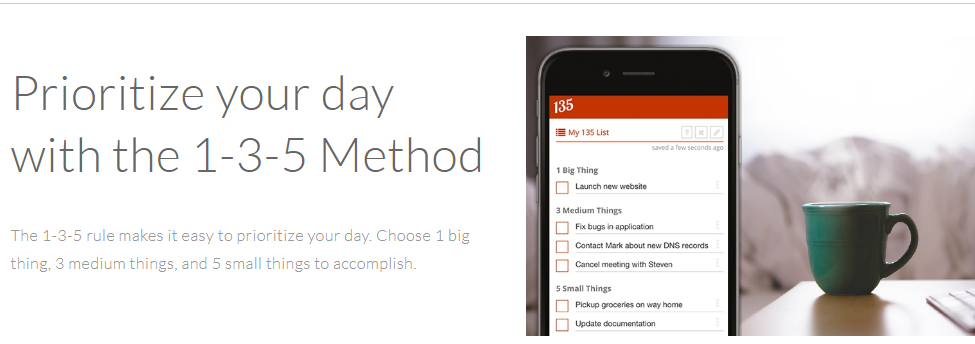
Unlike the previous time management systems, the 1-3-5 rule emerged just a couple of years ago. It was shaped by Alex Cavoulacos, the president and founder of The Muse, an online career platform listed among the best recruitment sites and praised by The Wall Street Journal and Fast Company. It’s an easy-to-implement productivity hack built on planning and prioritizing with added physical stimuli to encourage commitment and avoid procrastination.
The Essence
While most of us get frightened just seeing a long list of tasks planned for a workday, the 1-3-5 system allows cutting the to-dos to a doable number of assignments, thus removing the sense of overload and inspiring a greater desire to get to work. All you need to do within this time management system is to plan only nine tasks per day:
- one major time and energy-consuming task
- three tasks of medium load
- five easy-to-do assignments
The rule works for several reasons. First of all, it implies planning ahead, which is not the thing everybody is really committed to. Second, it makes you prioritize and review your plans daily to stay on track. Third, by writing down those nine items, you kind of make a bargain with yourself and take on obligations to complete the tasks. In addition, when you tick off the items at the end of the day, this gives you a feeling of accomplishment to encourage your further engagement.
And, surely, it is easier to embark upon a difficult task when you know that there is only one big challenge on your list. Yet, if you are forced to put off something planned, make sure to choose among smaller tasks.
Who Will Benefit
The rule is flexible enough to fit into different working styles and applicable to non-work activities as well. If your job is associated with unexpected tasks falling on you, you can reserve some time slots in your medium/small sections to cope with the problem. Teams can create and share a single 1-3-5 list, with each member contributing to checking the tasks off. However, frequent meetings and other interruptions can break the scheme; so, you may need to reduce the number of tasks on the list.
Digital Tools to Take On Board
One can go with a sheet of paper when implementing this simple time management system, but tech-savvy folks will be glad to use ready-made solutions.
- downloadable templates created by The Muse
- dedicated third-party apps like 135 List
- to-do lists apps, for instance, Microsoft To Do or Google Tasks
4. Kanban
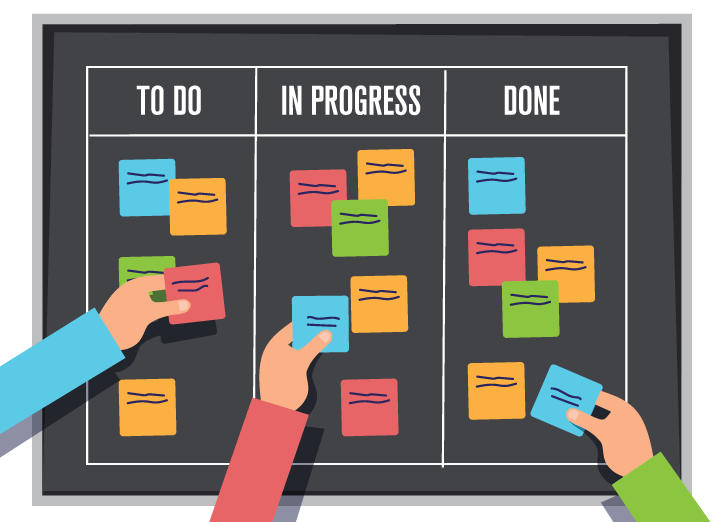
Kanban started as a scheduling system in manufacturing, first adopted at Toyota Motor Corporation in the late 1950s. It used cards to signal a demand for a product, hence the name (kanban means “signboard” in Japanese). In the early 2000s, the method migrated to software development and became part of the lean approach to company management. Further, Kanban was promoted for use in individuals and small teams by the Personal Kanban book published in 2011. Nowadays, this project and time management system based on visualization is widely used in various areas to keep track of workflows and maximize outcomes.
The Essence
The method rests on four main practices:
- Workflow visualization
Kanban boards serve to create a model of a current workflow and visualize it with the help of columns (they correspond to different work stages) and cards (they represent tasks within the whole process). The board is generally divided into three columns (To Do, In Progress, and Completed), but there can be more complex schemes to accurately mimic specific workflows. The tasks can be allocated to multiple team members with deadlines attached, and the cards move from left to right across the board as the work progresses. This gives a clear view of who is doing what and how the deadlines are met.
- Limiting work in progress
As you cannot perform many tasks simultaneously without burnout, quality loss, and risk of delays, the Kanban time management system requires limiting the number of work items in progress to some reasonable amount. The limits vary depending on many factors, but you can start with 2-3 tasks at a time and fine-tune the number as you gain more experience.
- Measuring and managing flow
Having a full picture of your workflow, you can collect various metrics like lead/cycle time and identify bottlenecks hindering efficiency. This knowledge will help you find areas for improvement and better predict task/project delivery dates.
- Establishing process policies
This point is applicable to teams rather than individuals, but inventing some rules and step-by-step guides by and for yourself can be no less useful. As for teams, the adoption of policies explaining how work should be done and what outcomes are expected is crucial to ensure both consistency and quality across team members and tasks.
Who Will Benefit
The Kanban system is perfect for companies since it contributes to an even workload distribution between staffers and makes the entire workflow transparent to all the team members. However, individuals, especially visual thinkers, can also benefit from incorporating Kanban into their work and personal matters.
Digital Tools to Take On Board
Although kanban boards were initially implemented in physical form and you can get by with a sheet of paper and stickers, many Kanban devotees prefer online boards, which are in excess nowadays.
- Kanban-focused apps like Kanban Zone, Kanban Tool, or KanbanFlow
- Project management tools, for example, ProofHub or Zoho Projects
5. 7 Minute Life
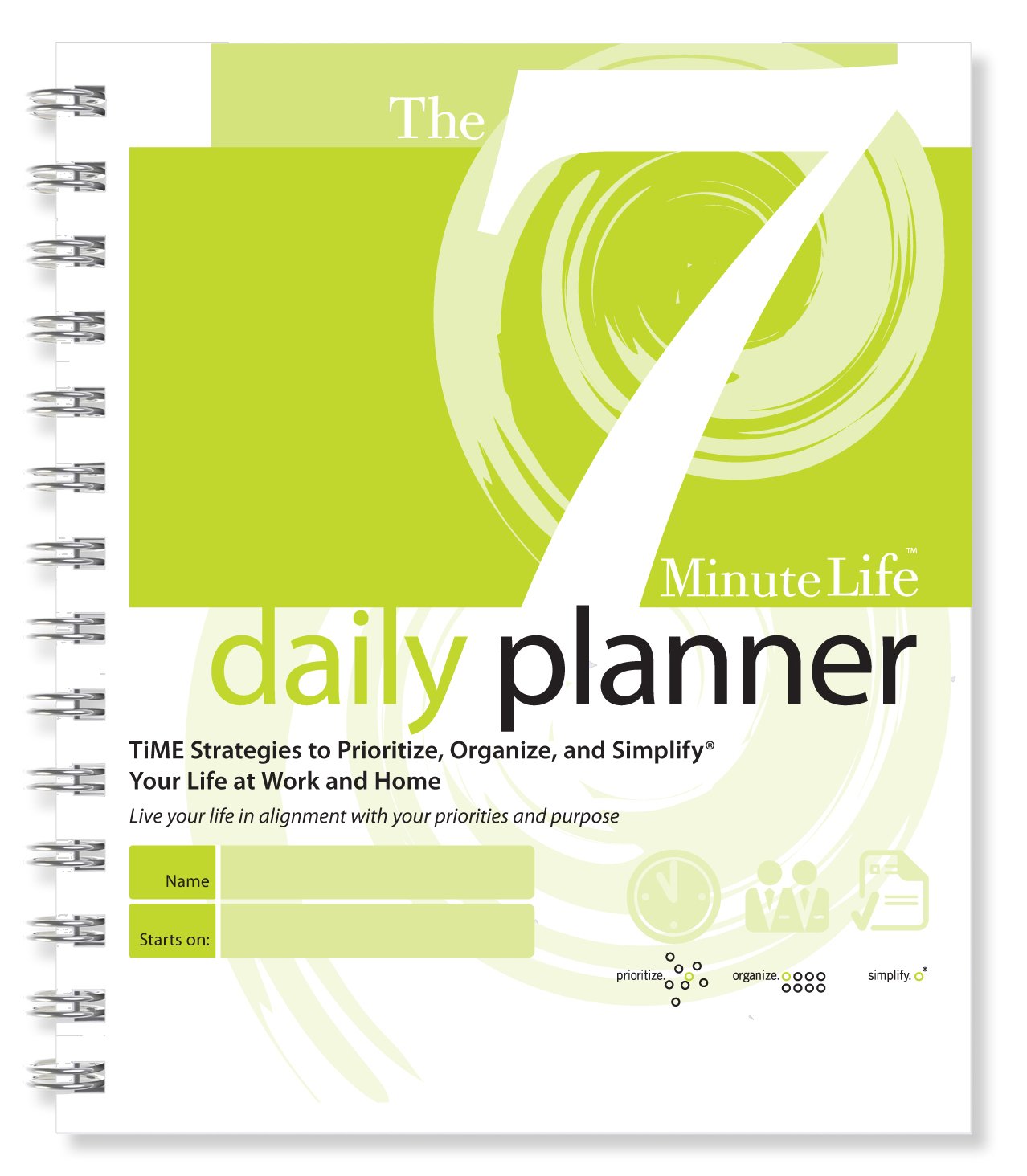
This time management system was invented in the early 2000s by Allyson Lewis, who was then working as a wealth adviser in the financial services industry with Fortune 100 companies like Morgan Stanley. She started with bringing her own busy life under control and grew into the CEO and founder of The 7 Minute Life, a time management and productivity company with clients ranging from Kellogg’s to the FBI. Lewis wrote four business books aimed to help busy people increase productivity at work, reduce stress, and find more time for their personal lives. Her system is based on planning, prioritization, and reflection.
The Essence
The main principle of the 7 Minute Life system is quite simple:
- Allocate seven minutes of your morning time to plan your day and choose five activities of the highest value to be completed before 11 a.m.
- Spend another seven minutes reviewing your progress throughout the day in the evening.
These 14 minutes make only 1% of a 24-hour day, which, as we all know, consists of 1,440 minutes. You should use this tiny portion of the time available to create a clear to-do list with expected deadlines to accomplish the tasks and convert it into an accurate timeline and a daily progress report with all the activities and steps sliced and diced.
The 7 Minute Life approach encourages you to grow into a habit of planning and prioritizing, yet it doesn’t end there. It is complemented with courses teaching how to clarify your goals, incorporate repeatable processes, improve focus, and reduce procrastination and distractions. Another supplemental material is a branded daily planner with an introduction to the system, checklists, worksheets, progress report pages, and more.
Who Will Benefit
This system is suitable for figures from the business community and academia, housewives, students, freelancers, and virtually any people who want to excel in personal time management. The daily planner adapted to the 7 Minute Life rules makes it even easier to get started.
Digital Tools to Take On Board
In addition to the planner available on Amazon and educational videos on the 7 Minute Life YouTube channel, you can use some technology-enabled tools to organize and track your daily tasks.
- a free official 7 Minute Life app for iOS devices
- planner apps, such as Friday or Any.do
6. AutoFocus
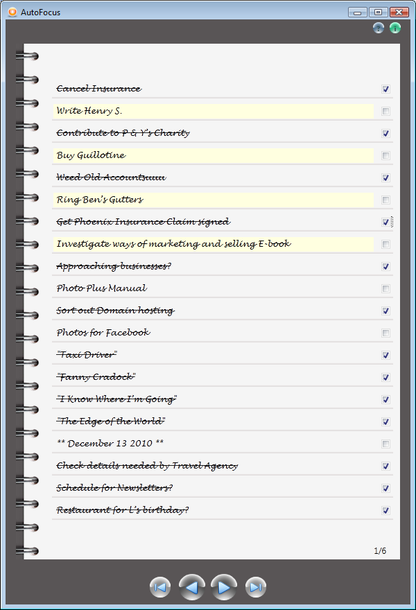
Many people will fall in love with this time management system just because it doesn’t require forcing yourself to bite into tasks that you don’t want to do. This revolutionary approach was offered by Mark Forster, a British business coach and author of five popular books on time management and productivity. The AutoFocus method places emphasis on motivation as the way to boost productivity since people tend to work faster and with greater commitment when they do want to tackle a problem. It also allows reducing stress and finding a better work-life balance.
The Essence
So, within this time management system, you don’t need to prioritize in the usual sense of the process, which relies on rational thinking and sorting tasks based on their importance and urgency. AutoFocus adds one more factor to this scheme, namely, intuition. Since, by our nature, we are not so much rational as many eggheads think, the conscious can clash with the subconscious, resulting in procrastination and disengagement. Forster suggests combining the two sides of our minds and breaks the process into the following simple steps:
- Get a lined piece of paper and write down all the tasks that come to your mind. If any new idea appears, put it at the end of the list regardless of its importance and urgency.
- Scroll down through the assignments without trying to make any decisions. The quick overview launches the process of assessing the tasks in your brain without any pressure.
- Read the items again but with greater attention until you stumble across the task that somehow stands out for you. Do not force yourself into conscious prioritization; just wait for the feeling that you are kind of ready to spring into action.
- Get down to it and work on the task as long as you like. The system gives preference to small portions of work done often and eagerly over pushing yourself to continue.
- Once you feel that you don’t want to proceed with the task, scratch it out and add it to the end of the list if you haven't finished it yet. The re-entering rule applies not only to uncompleted work but also repeated tasks, follow-ups, and long-term projects.
- Continue going through the same page until no tasks written on the page resonate with you. Think of each page as a separate block of tasks, while you are choosing between easier options and more difficult challenges, thus taking your procrastination under control.
- Go to the next page and repeat all over again.
- If you fail to come across a task that shines out for you after scanning the entire page, highlight all the remaining items with a marker as canceled without rewriting them to the end of the list. You should rethink these tasks later and re-enter them when you find this relevant, but they may require splitting into smaller tasks or rewording to become more specific and appealing. This step does not apply to the last page where you keep adding new tasks.
- Once you are done with the last page, go to the first one containing unfinished tasks.
AutoFocus makes workflows less stressful since it removes the sense of pressure and allows you to really enjoy what you are doing. It also boosts productivity in working with routine tasks and large projects while being simple to implement.
Who Will Benefit
The AutoFocus time management system fits well into work, hobbies, and household chores, but it doesn’t work that great with appointments and scheduled tasks like meetings when you cannot choose time for getting to them. But with some limitations, this method will be highly appreciated by people prone to procrastination and poor concentration no matter the field they work in.
Digital Tools to Take On Board
The author recommends using any ruled notepad you find convenient, but if you are in bed with your computer or smartphone, you may opt for its electronic version.
- note-taking apps like Evernote, Microsoft OneNote, or Apple Notes
- to-do lists software, such as Todoist, Microsoft To Do, or OmniFocus
7. Bullet Journal
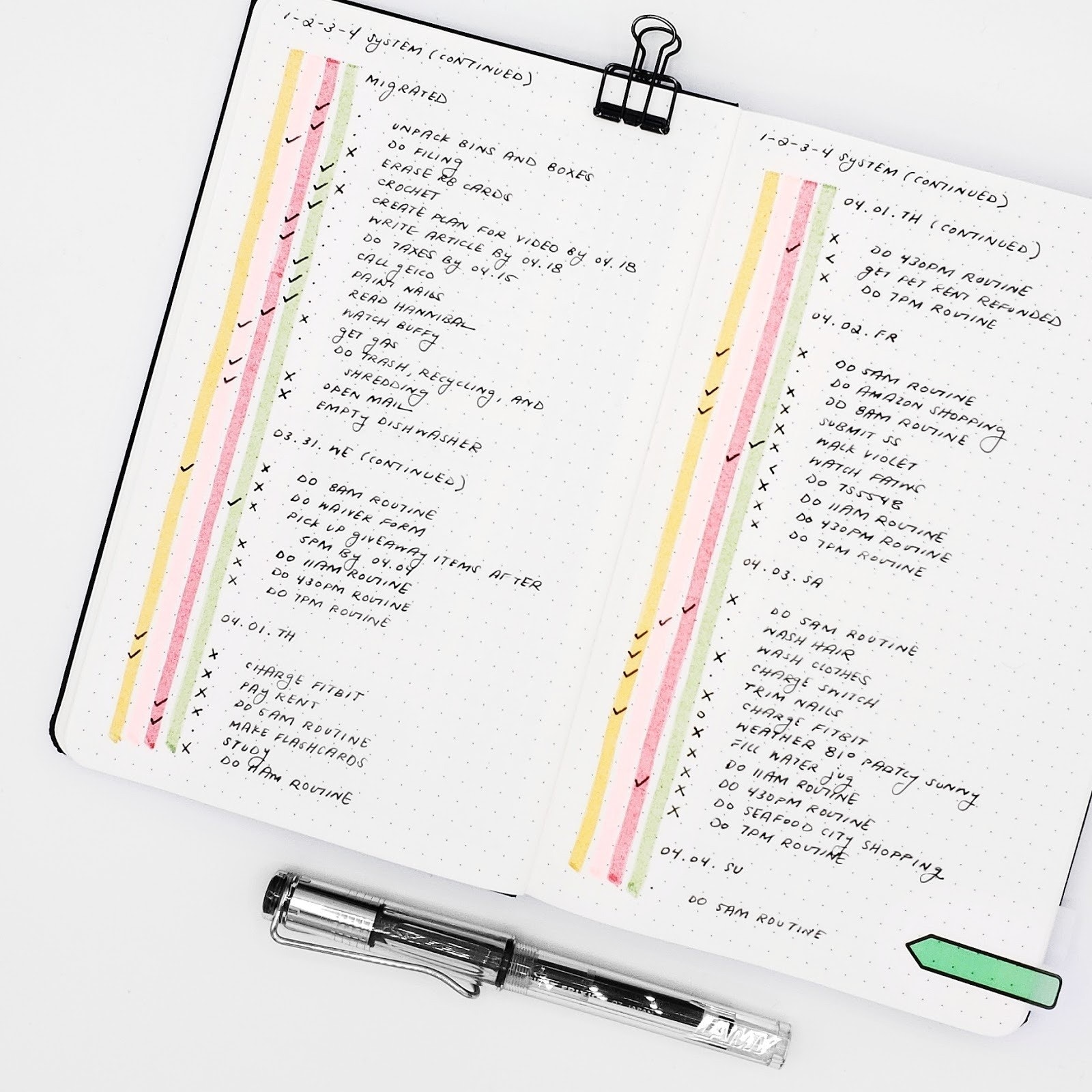
This time management system looks like a variation of the previous method since it also requires note-taking. Yet, the approach to organizing your tasks is quite different, and we can expect more benefits at least for people with an analytical mindset. We owe a debt to Ryder Carroll, a digital product designer and a person who suffered from attention deficit disorder in childhood, for the Bullet Journal method and the book of the same name published in 2013. The system offers a single yet flexible tool for personal time management, which is a notebook where you organize information using special symbols and modules.
The Essence
Much like with the AutoFocus system, you need to write down all kinds of information related to your daily tasks, be it a work assignment or a meeting with friends, but you do this in the form of bulleted lists. To keep the information concise yet clear and well-organized, you should put it down on paper in short phrases complemented with symbols designated for different content types:
- Tasks. They are labeled with a dot ( • ) and include things you need to do. As you deal with the tasks, their status is changed to:
- completed — X
- migrated into one of the four main collections — >
- scheduled into Future Log — <
- irrelevant — scratched out
- Notes. They are marked with a dash (–) and contain information you want to keep in mind, for example, ideas and observations.
- Events. They are indicated by a circle (◦) and cover date-related experiences, either forthcoming or obtained, including your own actions you might find worth reflecting on.
The system also encourages you to use various signifiers, which are symbols placed to the left of a bullet to give additional meaning to the entry. For example, an asterisk usually highlights a priority task, but you are free to invent your own system of signifiers.
You can make these entries without sticking to any particular order or group connected tasks, events, and notes to better organize the flow of information. However, you should always start taking notes by writing down a short and descriptive topic, which varies depending on the content, and numbering the page. Later, you will use topics and page numbers to create an index located at the very beginning of your notebook and serving for easier navigation through its content. Basically, your index will include:
- Future Log — a collection of information related to tasks and events planned on any time outside the current month;
- Monthly Log — a collection of entries for the current month with a calendar page for scheduling and a task page for inventory.
- Daily Log — a collection of entries logged daily as they pop up.
You are also welcome to create other logs and collections to store and clearly organize tasks, events, and notes related to specific topics like your diet or reading list. At the end of every month, you need to go through your current Monthly Log and mark all the tasks based on the above status system while moving relevant and uncompleted tasks to corresponding collections. Another step to do regularly is reviewing your Future Log and timely migrating entries into Monthly or Daily Logs.
Who Will Benefit
The Bullet Journal time management system stands out for neatly combining a day planner, ideas collection, diary, and to-do list under one umbrella. It is equally great for scheduling, reflection, brainstorming, or habit tracking, so many people of different professions can avail of it on a personal level. However, you may find the method to be time-consuming or land in procrastination, spending more time polishing your journal instead of actually performing tasks.
Digital Tools to Take On Board
Handwritten notebooks have their charm and allow triggering our brains’ engagement, but digital e-journals provide different opportunities like audio recording or fast searching through content. So, you can use paper versions or their digital analogs as you deem fit.
- Bullet Journal Companion for iOS and Android developed by the creator of the system
- third-party apps designed for digital bullet journaling (Dynalist, GoodNotes, or Day One)
8. Iceberg Method
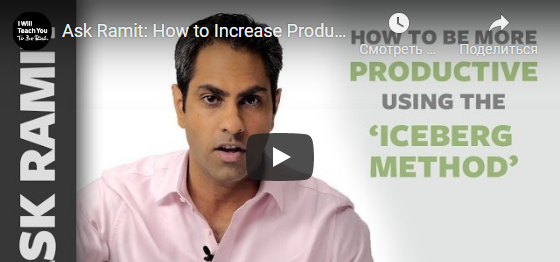
This method is similar to the GTD time management system in the assumption that we need to unload excessive information from our heads in order to stay more focused on current tasks and work more productively. Yet, the approach developed by Ramit Singh Sethi, an alumnus of Stanford University, personal finance advisor, motivational speaker, and successful entrepreneur, doesn’t deal with tasks — it applies to sorting out and storing valuable information that we are not going to use immediately. In 2009, Ramit Sethi published I Will Teach You to Be Rich, a New York Times bestseller, where he explained the system that can save you plenty of time and effort if you bother to embrace it.
The Essence
The inventor compares this method to an iceberg for a reason — being quite simple to implement, it gives you fast access to a wealth of information, otherwise hidden beneath the water, just when you need it. Instead of wasting your time and energy reviewing sources you are not going to apply right now and trying to memorize ideas unfit for your current tasks, you should develop a habit of saving pieces of useful information in a convenient system tailored to your specific needs.
- Whenever you stumble across something interesting that may come in handy one day, file it away in some kind of folder. The information to store can vary from links to helpful online resources to inspirations picked up from books you read. The main idea is to save them in one place that is easy to access.
- Organize your collection with the help of tags, folder names, or any other way suitable for you. Be specific when labeling your intelligent database so that you can find what you need breezily.
- Review your collection every four-six weeks to learn whether there is something you can use for your current tasks. And surely, if a project rings the bell, go to your storage and retrieve the information required.
The Iceberg method allows you to avoid distractions you inevitably face when trying to keep too many things in your head. On the other hand, it saves you plenty of time otherwise spent searching for necessary information. Someday, you are likely to find out that a good portion of the materials you need to complete a task is at your fingertips. Besides, the method ensures that you don’t waste your time reading emails, books, and articles since you do apply the knowledge derived from them.
Who Will Benefit
The Iceberg method will be especially useful for those people who do a lot of research, or constantly seek inspiration, or deal with a huge stream of emails. It is also suitable for usage in teams that want to collect and share ideas for further collaboration.
Digital Tools to Take On Board
Actually, the system was created with digital solutions in mind since its author recommends starting your journey by sorting emails in your inbox and storing useful information there. However, you are not limited to email folders, and there are other convenient options.
- PBworks real-time collaborative editing system created with contributions from Ramit Sethi
- wiki tools like Tettra
- note-taking apps, including Evernote, Google Keep, or Microsoft OneNote
- collaborative services, such as Dropbox Paper
9. Dave Lee’s System
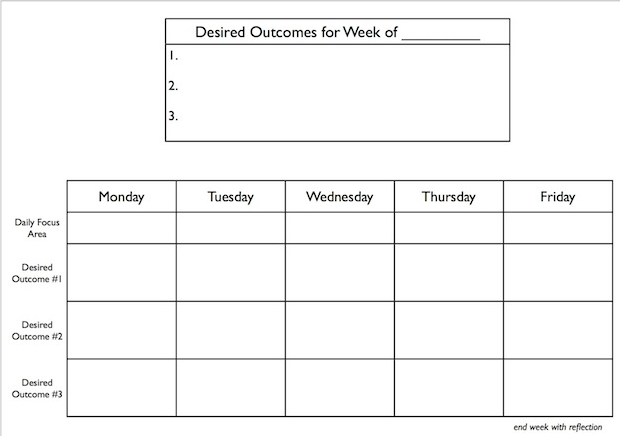
People who are not comfortable with an uninterrupted flow of tasks and projects can borrow some ideas from Dave Lee, who is an app developer and an investor/YouTuber with a focus on innovative companies. As innovation goes hand in hand with creative thinking, Lee got interested in developing a productivity system that would leave more space for experiments and remove information overload, thus promoting creativity. He suggests switching to daily focuses and reducing the number of tasks to a minimum to avoid stress, stay productive, and keep the working process enjoyable.
The Essence
We may say that this time management system combines some features of the previously mentioned techniques, including Pomodoro, GTD, and Iceberg, but adds the clarity of focus and the flexibility of the process.
- Identify the five most important areas of your work for a week to have a dedicated area per workday. Depending on your workflow, you can assign the same Daily Focus Area to more than one day. If possible, attach these daily focuses to the same days of the week, for example, focus on meetings with clients on Mondays and fix bugs on Fridays.
- At the beginning of the week, think through three desired outcomes of the week and write them down in your Week Chart using past tense to denote completed action.
- At the beginning of each day, define three desired outcomes of the day and list them in the chart along with the corresponding Focus Area. Make sure that the outcomes are related to the Focus Areas and realistic enough to fit into your day.
- Make the chart visible throughout the day to stay focused and motivated and keep your work area clean to avoid clutter.
- Organize each Daily Focus as a separate project by making a short list of related tasks and adding notes with key information only.
- Store other pieces of information that are not immediately required to complete a project in organized spaces for further reference.
- Place a priority on actions connected to Focus Areas and Desired Outcomes and leave irrelevant tasks like routine email checking for later.
- Work in intense 25-minute sessions and take small and long breaks in-between.
- Allocate some time to reflect on your Week Chart at the end of the week and analyze your failures if any.
Who Will Benefit
This time management system deserves giving a try if you work in creative fields where daily tasks are quite ambiguous. It will give you some structure while retaining flexibility and allow you to focus on goals instead of sweating over defining tasks and next actions.
Digital Tools to Take On Board
While you need only a piece of paper to outline a Week Chart and Dave Lee even insists on having it before your eyes in hard copy, you can also add some digital tools to your arsenal.
- digital timers, such as Pomotodo
- file hosting services like Dropbox
- project management platforms, for example, Asana
10. Eisenhower Matrix
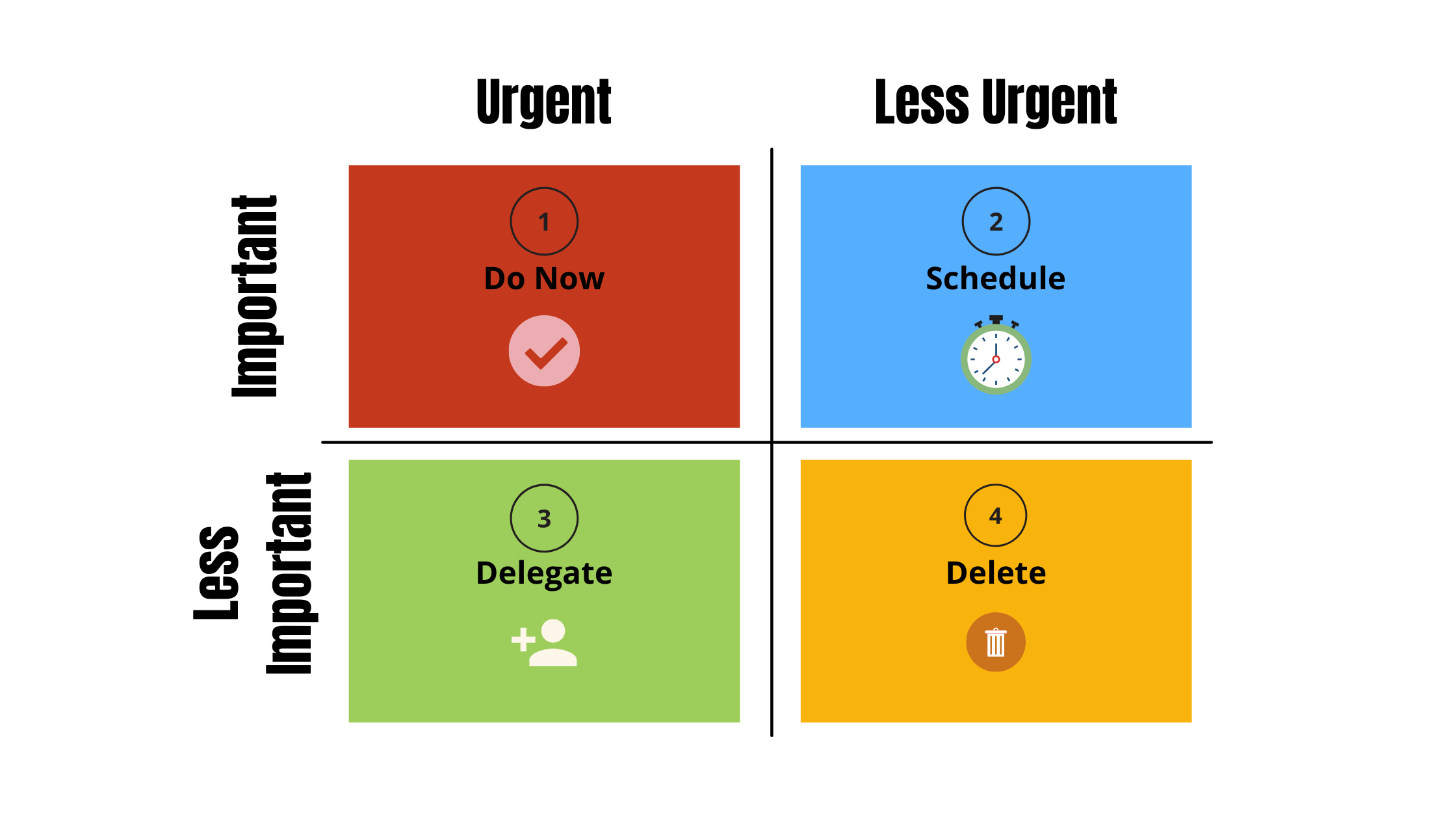
Frankly speaking, the 34th president of the United States Dwight Eisenhower didn’t invent this time management system, although he did organize his work efficiently through prioritization and sorting tasks based on urgency and importance. The matrix was shaped and popularized by Stephen Covey, a famous businessman, educator, organizational consultant, and motivational speaker, in his bestseller The 7 Habits of Highly Effective People, first published in 1989. It delivers an easy-to-follow guide on juggling priorities to balance workload and increase performance.
The Essence
First, you need to comprehend two basic principles — urgent things are not always important, and you don’t have to snatch at each problem that comes your way. Here is the matrix to guide you through the prioritization challenge:
- Outline an Eisenhower box divided into four quadrants to sort your tasks.
- Name the boxes as follows: Do, Schedule, Delegate, and Delete.
- Put urgent and important tasks into the Do part. It should include all problems that could lead to disaster if not tackled on the due date, namely, last-minute deadlines, emergency meetings, unforeseen events, and crises. You need to deal with these tasks ASAP and personally.
- Enter important yet not urgent tasks into the Schedule quadrant. Important tasks work towards your long-term goals but don’t come with pressing deadlines. You should schedule them to do later and get down to the assignments right upon completing your urgent tasks. This section would include not only your work-related tasks but also recreation, learning, relationship building, finding inspiration, and other areas aligned with your goals and values.
- List urgent but not important tasks in the Delegate box. These are problems that don’t need your personal attention and specific expertise, so they can be handled by other people to remove interruptions from your workflow. The list can cover emails, reports, meetings, phone calls, and other issues that don’t help meet your goals but are related to someone else’s needs. Find a team member or a friend who can do the job instead of you and make sure to keep track of the delegated task.
- Place no-rush and unimportant matters into the last section and try to avoid these distractions. They usually include time-wasters like gossiping, watching TV, gaming, surfing the web, and so on. These activities do not contribute to achieving your goals, so you need to analyze your bad habits and do your best to eliminate them.
Note that tasks placed in the Schedule quadrant are your best productivity boosters, which implies that you should spend most of your time in this section rather than in the third or fourth quadrants. It would be smart to track your tasks and the time they take for a week and then to sort them into the Eisenhower boxes so that you could learn where your time and energy go. You can fix the problems identified by anticipating and preventing urgent matters, creating a strategy to delegate tasks, or finding ways to remove distractions.
Who Will Benefit
The Eisenhower time management system is tailored to the needs of business leaders and managers, but it is also helpful for people who suffer from procrastination or overload. It allows them to streamline a flow of different tasks and avoid spreading themselves too thin.
Digital Tools to Take On Board
You can go with a paper planner or downloadable PDF files with four quadrants ready for use, but there are also more elaborated and feature-rich options.
- the Eisenhower matrix-themed solutions like Ike, Eisenhower Matrix, or Focus Matrix
- list-making apps (Trello, Any.do, or Todoist, to name a few)
Bonus Time Management System: Time Tracking with Controlio
In fact, you don’t need a digital tool to help you with implementing some time management system, as today’s software is smart enough to be the system itself. Time tracking apps allow monitoring tasks performed on computers and mobile devices to record time spent working or doing non-work activities and identify productivity loopholes to fix them immediately. Controlio is a time tracker from Work Examiner series of employee monitoring software developed by EfficientLab, a tech company with products recognized among the best on the market by PCMag and TechRadar. Designed as a feature-packed tool for Windows and macOS-powered devices, it works on both individual and corporate levels.
The Essence
Controlio is available as a cloud-based service and on-premise software, meaning that you can install the client program on remote desktops and store data in a cloud or use it within your own LAN with data stored on your server. Upon creating an account with Controlio, you get access to the dashboard where information recorded by the app is visualized and where the account owner (or a person with admin rights) can change settings. The software records apps and websites opened by users on all the computers connected and captures interactions with the mouse and keyboard to calculate productivity metrics.
- One of the main insights delivered by Controlio is the Productivity Score.
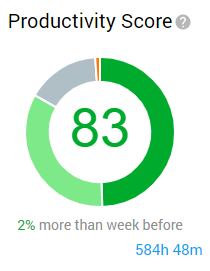
This metric is measured based on websites and apps usage. Each of them falls into a certain category of tools with different levels of productivity assigned. The levels range from very distracting to very productive: for example, Microsoft Outlook belongs to the Email category labeled as productive, while Adobe Acrobat Reader is considered one of the General apps with the neutral productivity level. Controlio calculates time spent by users in productive and unproductive activities and delivers their productivity scores as a percentage, with the highest possible value being 100%. An admin can adjust categories and productivity levels as they deem fit to better match the company’s workflow.
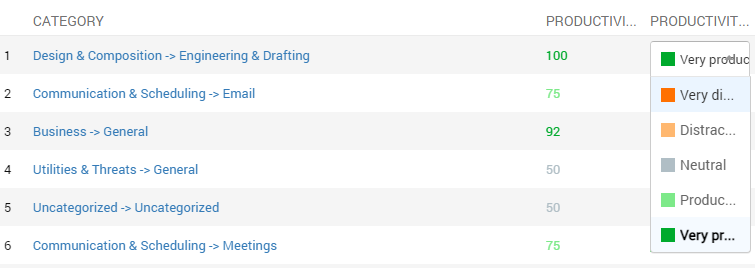
Depending on the privileges established, an employer, manager, or even an employee gets access to the scores to see how an individual, a team, or the whole company performs. If the settings are accurate, low scores signalize the heavy usage of distractive digital solutions like social media, news websites, or chat apps, which should be addressed properly to improve efficiency. To give you both full and granular pictures, productivity scores can be filtered by user, department, and time, while Controlio automatically compares the current metric with the previous period.

- Another parameter worth your attention is a total/active/idle time ratio.

Active time is recorded when a user interacts with the mouse or keyboard, so the Activity Ratio calculated by Controlio as an active time to total time ratio is a great benchmark to assess the user’s focus, attendance, and diligence. A low activity ratio suggests that the person is often away from the computer, prone to procrastination, or lacks concentration. To make this metric more precise, Controlio allows adjusting idle time parameters: for example, you can set idle time starting after 5 or 10 minutes of a user’s inactivity or establish even longer inactivity periods for meeting apps.
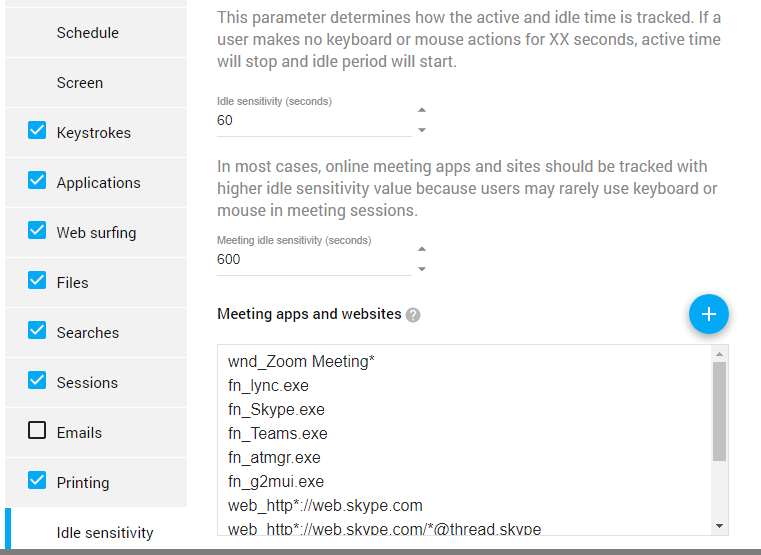
Meanwhile, active time values provided by Controlio can be used by managers to calculate actual working hours or by users to learn how much time they spent performing a task.
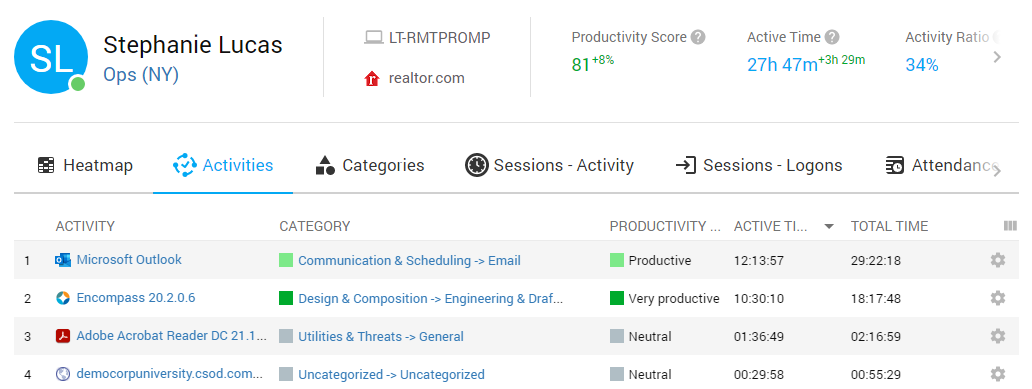
- Another parameter worth your attention is a total/active/idle time ratio.
Attendance is also tracked by Controlio based on mouse/keyboard interactions. This allows for clear visualization of time distribution throughout a day, with all pauses made and tools used in periods of activity. Not only does the hourly breakdown serve as proof of a user’s attendance, which is important for supervisors, but it’s also helpful for both parties to understand whether there are enough breaks taken to avoid burnout.
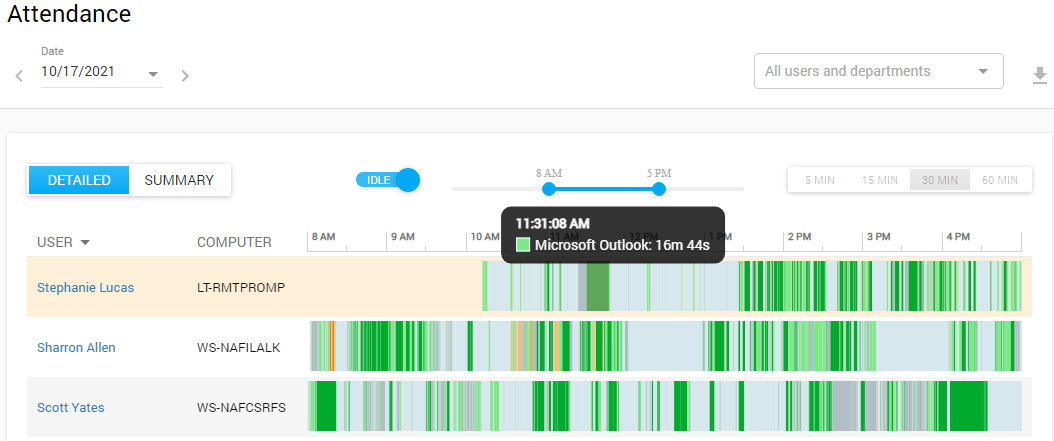
- In addition to attendance, Controlio displays the time when users start and finish a workday. It records this time in two ways: when a user logs in/out and when the person starts/finishes using the mouse and keyboard. Thanks to this, Controlio delivers valid data on working sessions, helps to spot users getting to work late, and, at the same time, informs about overtime.

- Controlio monitors online sessions and provides this information in real-time.
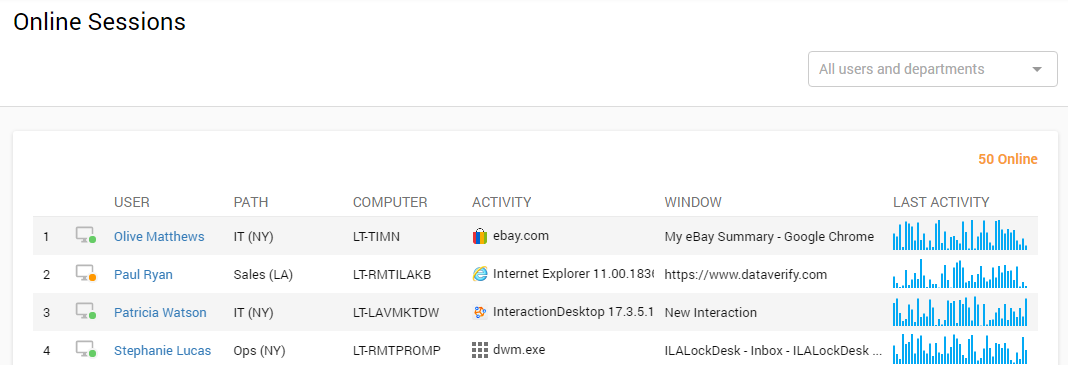
All users currently active are displayed in the corresponding section along with tools they are using and live streams of their computer screens. It’s a worthwhile feature for team leaders since they can keep their finger on the pulse without bothering other team members and step in if some of them swing off the course.
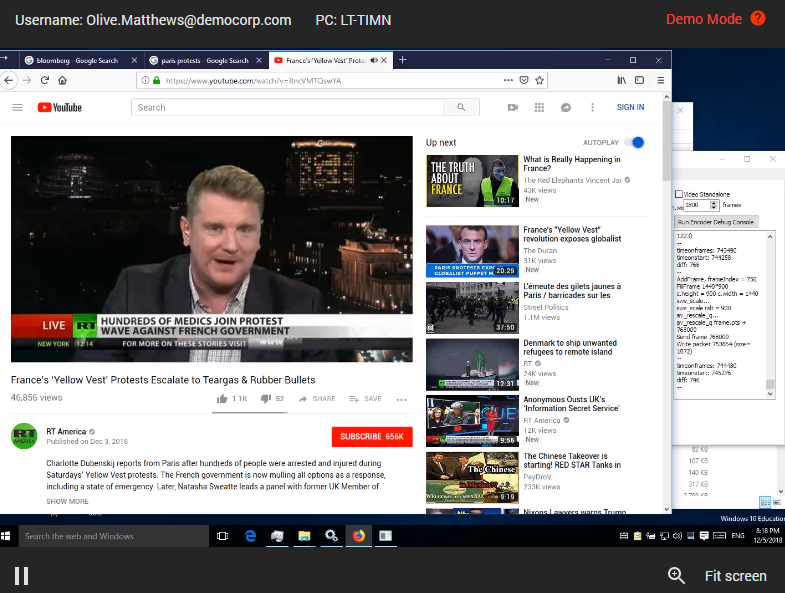
- If you want to explore productivity patterns across teams and individuals, the app handles this task perfectly. To start with, it generates a heatmap for each user, showing how their performance changes throughout a week or day.
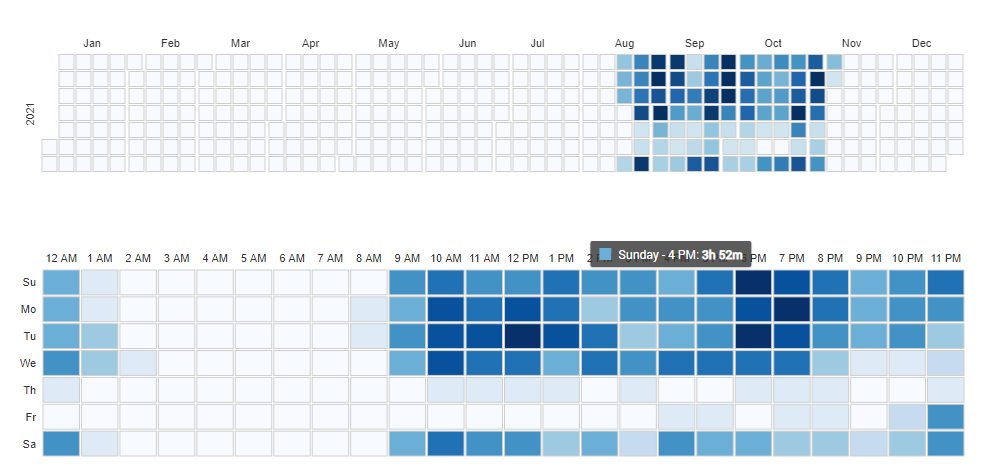
Another visualization to avail of is activity hours, which reveals active time distribution during a day. If you are more interested to know what part of a day is spent performing work-related tasks or, vice versa, wasted on non-work activities, the Productivity Bar displays all the productivity levels in hours and a percentage.
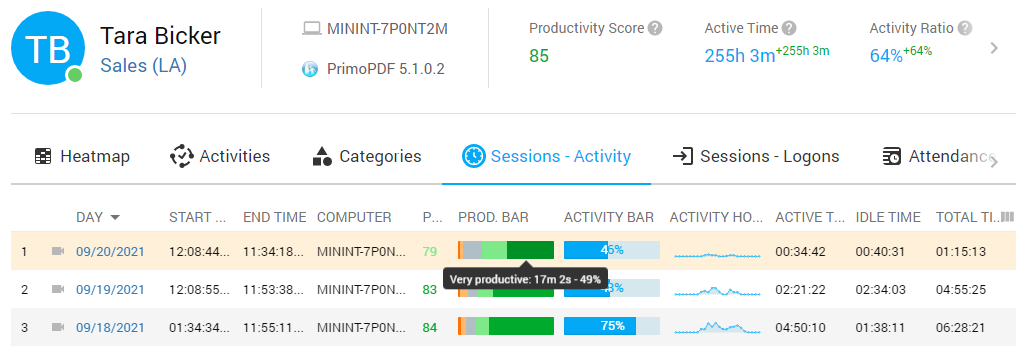
By analyzing information on user behavior, you will be able to better adjust work schedules to productive hours, define role models to encourage higher commitment, and make other informed business decisions to boost performance.
- While most time management systems offer advice on dealing with distractions, Controlio gives a hands-on tool for its users to stay off at least the most common bad habits. It has a websites/apps blocking feature, which can be applied to different users and departments selectively.
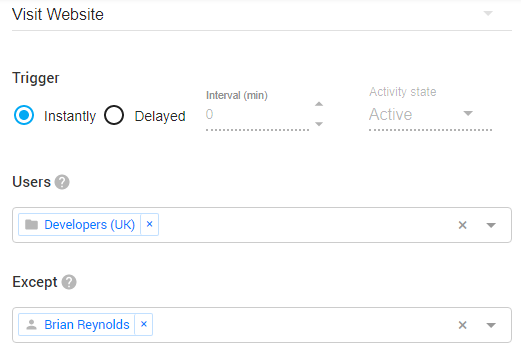
You can create rules for potentially distractive resources accessibility in several clicks since Controlio comes with its own database of apps and websites numbering hundreds of platforms. So, you are free to enter specific URLs and app names manually or block whole categories of time-wasters like online shops or social networking sites.
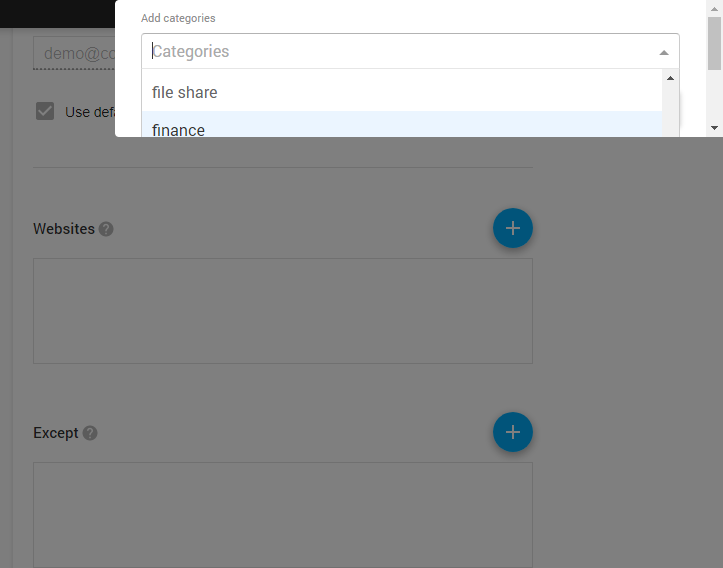
Thanks to the flexibility of this feature, blocking won’t interfere with your workflow specifics, and users will still be able to use non-work websites and apps yet only when they are permitted.
Who Will Benefit
Controlio is beneficial for freelancer teams, remote workers monitoring, companies with hybrid work opportunities, digitally fueled SMBs, and large enterprises alike. It tracks time, evaluates performance, and generates tons of useful information for both regular users and management teams. Employers are entitled to invite employees for self-monitoring and allow their staffers to turn the surveillance on/off, which creates a transparent working environment and contributes to building trust.
Digital Tools to Take On Board
Besides all the above time tracking features, Controlio boasts a wide range of tools to prevent data leaks and address workplace misconduct:
- print-outs, email, and documents monitoring
- keystrokes and searches capturing
- removable storage devices blocking
- screen recording
- alerts setting
- audit logging
All in all, Controlio is a powerful time tracking solution compatible with popular time management systems since it helps detect time drains and fix some of the leaks. You can take notes, make schedules, and create to-do lists in other apps and then compare your planned productivity with accurate metrics provided by Controlio.
Share a post
Start to monitor employees instantly!
Install our solutions all over your network within 5 minutes